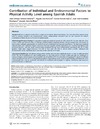Identificador persistente para citar o vincular este elemento:
https://accedacris.ulpgc.es/jspui/handle/10553/48271
| Título: | Contribution of individual and environmental factors to physical activity level among spanish adults | Autores/as: | Serrano-Sanchez, José Antonio Lera-Navarro, Angela Dorado-García, Cecilia González-Henriquez, Juan José Sanchis-Moysi, Joaquin |
Clasificación UNESCO: | 32 Ciencias médicas 241106 Fisiología del ejercicio |
Palabras clave: | Nationally Representative Sample Social-Cognitive Determinants Leisure-Time Outcome Expectations Public-Health, et al. |
Fecha de publicación: | 2012 | Publicación seriada: | PLoS ONE | Resumen: | Background: Lack of physical activity (PA) is a major risk for chronic disease and obesity. The main aims of the present study were to identify individual and environmental factors independently associated with PA and examine the relative contribution of these factors to PA level in Spanish adults. Methodology/Principal Findings: A population-based cross-sectional sample of 3,000 adults (18–75 years old) from Gran Canaria (Spain) was selected using a multistage stratified random sampling method. The participants were interviewed at home using a validated questionnaire to assess PA as well as individual and environmental factors. The data were analyzed using bivariate and multivariate logistic regression. One demographic variable (education), two cognitive (self-efficacy and perceived barriers), and one social environmental (organized format) were independently associated with PA in both genders. Odds ratios ranged between 1.76–2.07 in men and 1.35–2.50 in women (both p<0.05). Individual and environmental factors explained about one-third of the variance in PA level. Conclusions/Significance: Self-efficacy and perceived barriers were the most significant factors to meet an adequate level of PA. The risk of insufficient PA was twofold greater in men with primary or lesser studies and who are employed. In women, living in rural environments increased the risk of insufficient PA. The promotion of organized PA may be an efficient way to increase the level of PA in the general population. Improvement in the access to sport facilities and places for PA is a prerequisite that may be insufficient and should be combined with strategies to improve self-efficacy and overcome perceived barriers in adulthood. | URI: | https://accedacris.ulpgc.es/handle/10553/48271 | ISSN: | 1932-6203 | DOI: | 10.1371/journal.pone.0038693 | Fuente: | PLoS ONE [ISSN 1932-6203], v. 7 (e38693) |
| Colección: | Artículos |
Citas SCOPUSTM
24
actualizado el 08-jun-2025
Citas de WEB OF SCIENCETM
Citations
20
actualizado el 08-jun-2025
Visitas
215
actualizado el 31-oct-2024
Descargas
157
actualizado el 31-oct-2024
Google ScholarTM
Verifica
Altmetric
Comparte
Exporta metadatos
Los elementos en ULPGC accedaCRIS están protegidos por derechos de autor con todos los derechos reservados, a menos que se indique lo contrario.
